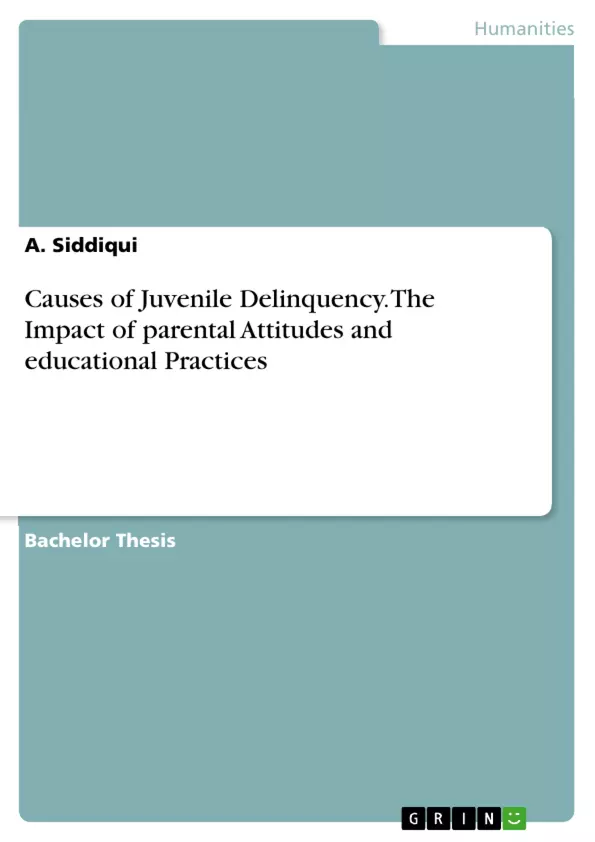The work deals with the question of what influence parental attitudes and educational practices have on the development of violent crime among adolescents. At the beginning the approach of juvenile delinquency is explained. This is followed by an empirical part in which the development of violence is explained. Then the connection to parent-child violence is described.
Healthy upbringing and the associated learning of social skills at the individual level in the form of interpersonal interaction is very important. Such an education also has an indirect effect on the societal level, with institutions such as kindergartens and schools now also having a secondary role alongside parents. socialization instances play a formative role. As a rule, this ensures that children and adolescents are steered in the right direction and behave in accordance with society.
However, not every young person is brought up well or healthily and this can have extensive consequences. Perhaps the worst consequence could be that they do not accept prosocial attitudes and values. Prosocial behaviour is desired by society and is in line with social and legal norms. Conversely, this leads to the assumption that antisocial behaviour could increase the likelihood of delinquent behaviour. Delinquent behaviour can have fatal consequences which can have extremely negative effects within society. This in turn leads to the question of which factors are responsible for criminal behaviour among young people.
Table of Contents
- I. INTRODUCTION
- A. DEDUCTION OF THE PROBLEM
- B. PREVIOUS RESEARCH
- C. FORMULATION OF THE RESEARCH QUESTION & METHODOLOGY
- II. THEORETICAL PART
- A. DEFINITIONS
- 1. (JUVENILE-) DELINQUENCY
- B. AN APPROACH TO EXPLAIN JUVENILE DELINQUENCY
- 1. SOCIALIZATION THEORETICAL APPROACH
- 2. LEARNING THEORY ACCORDING TO BANDURA
- 3. BINDING THEORY ACCORDING TO SPANGLER & ZIMMERMANN
- 4. CRITICAL APPRECIATION
- C. HYPOTHESES
- A. DEFINITIONS
- III. EMPIRICAL FINDINGS
- A. DEVELOPMENT OF THE FACTUAL (PHYSICAL) VIOLENCE
- 1. PRESENTATION OF THE STUDY BY PETER WETZEL (1997)
- 2. PRESENTATION OF THE STUDY KFN - STUDENT SURVEY (1998)
- 3. PRESENTATION OF THE STUDY DIRK BAIERS' ET AL. (2009)
- B. DEVELOPMENT OF ATTITUDES TOWARDS PARENT-CHILD VIOLENCE
- 1. PRESENTATION OF THE STUDY BY KAI D. BUSSMANN (1996 & 2001)
- 2. PRESENTATION OF THE STUDY BY PLENER ET AL. (2016)
- C. DEVELOPMENT OF THE JUVENILE DELINQUENCY OF VIOLENCE
- 1. RESULTS OF THE STUDY BY THE PKS AND THE KFN SCHOOL SURVEY (2018)
- D. PRELIMINARY SUMMARY
- E. VIOLENT DELINQUENCY - A UNI- OR MULTIVARIABLE PHENOMENON?
- A. DEVELOPMENT OF THE FACTUAL (PHYSICAL) VIOLENCE
Objectives and Key Themes
This bachelor thesis aims to investigate the impact of parental attitudes and educational practices on the development of violent delinquency in adolescents. It explores the complex relationship between family dynamics and the emergence of criminal behaviour among young people.
- The role of parental socialization in shaping adolescent behaviour
- The influence of parenting styles and family dynamics on the likelihood of delinquency
- The impact of intra-family violence and abuse on adolescent development
- The interplay between social and psychological factors contributing to violent delinquency
- The significance of social institutions and their role in shaping social norms and behaviour
Chapter Summaries
The introduction sets the stage for the thesis by outlining the problem of juvenile delinquency and highlighting the importance of understanding the role of parental attitudes and practices. It reviews existing research on family socialization and its influence on delinquency. The theoretical part dives into the conceptual framework, defining key terms and exploring theories that explain juvenile delinquency, such as socialization theory, learning theory, and binding theory.
The empirical findings section presents several studies that investigate the development of violent behaviour, attitudes towards parent-child violence, and the emergence of juvenile delinquency. This section provides evidence from various research projects, highlighting the complex and multifaceted nature of these issues.
Keywords
This thesis focuses on the crucial keywords and concepts of juvenile delinquency, parental attitudes, educational practices, family socialization, parenting styles, intra-family violence, and the development of violent behaviour in adolescents.
- Quote paper
- A. Siddiqui (Author), 2019, Causes of Juvenile Delinquency. The Impact of parental Attitudes and educational Practices, Munich, GRIN Verlag, https://www.grin.com/document/950894



